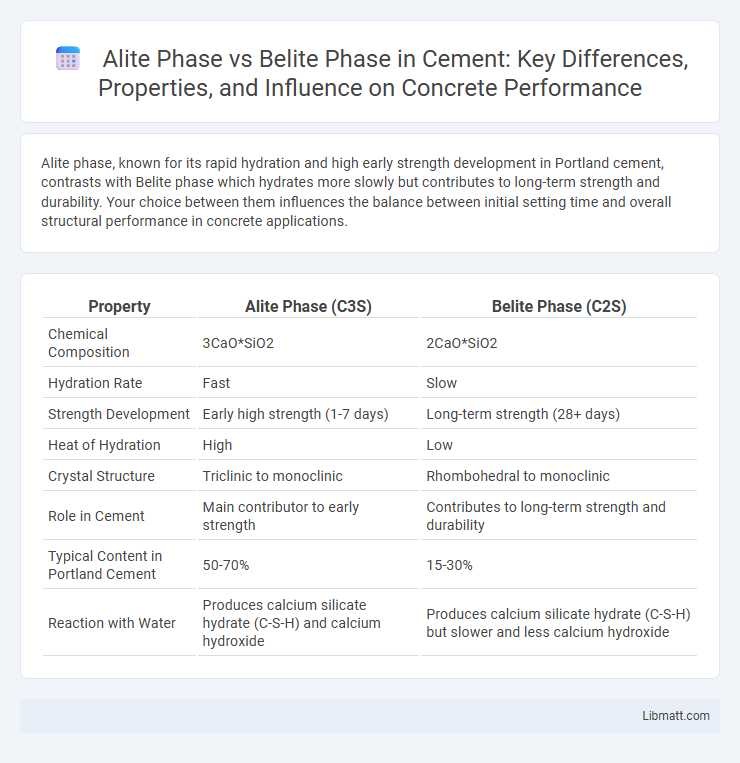Alite phase, known for its rapid hydration and high early strength development in Portland cement, contrasts with Belite phase which hydrates more slowly but contributes to long-term strength and durability. Your choice between them influences the balance between initial setting time and overall structural performance in concrete applications.
Table of Comparison
| Property | Alite Phase (C3S) | Belite Phase (C2S) |
|---|---|---|
| Chemical Composition | 3CaO*SiO2 | 2CaO*SiO2 |
| Hydration Rate | Fast | Slow |
| Strength Development | Early high strength (1-7 days) | Long-term strength (28+ days) |
| Heat of Hydration | High | Low |
| Crystal Structure | Triclinic to monoclinic | Rhombohedral to monoclinic |
| Role in Cement | Main contributor to early strength | Contributes to long-term strength and durability |
| Typical Content in Portland Cement | 50-70% | 15-30% |
| Reaction with Water | Produces calcium silicate hydrate (C-S-H) and calcium hydroxide | Produces calcium silicate hydrate (C-S-H) but slower and less calcium hydroxide |
Introduction to Alite and Belite Phases
Alite and Belite phases are critical components in Portland cement chemistry, with Alite (C3S) responsible for early strength development due to its rapid hydration. Belite (C2S) hydrates more slowly, contributing to long-term strength and durability in concrete structures. The proportion and reactivity of these phases determine cement performance, influencing setting time, strength gain, and overall durability.
Chemical Composition of Alite and Belite
Alite phase primarily consists of tricalcium silicate (3CaO*SiO2), characterized by a higher calcium oxide (CaO) content and lower silica (SiO2) compared to belite. Belite phase is composed of dicalcium silicate (2CaO*SiO2), featuring a relatively lower CaO content and higher SiO2 concentration, influencing the hydration rate and strength development in cement. Understanding the chemical composition of Alite and Belite is essential for optimizing the performance and setting time of Portland cement in Your construction projects.
Formation and Crystal Structure
Alite phase forms at higher temperatures in Portland cement clinker, characterized by a monoclinic or triclinic crystal structure rich in calcium silicates, specifically Ca3SiO5. Belite phase forms at lower temperatures and exhibits a more stable orthorhombic crystal structure, predominantly composed of Ca2SiO4. Understanding your cement's performance depends on the ratio of alite, which provides early strength, to belite, which contributes to long-term strength due to their distinct formation temperatures and crystal configurations.
Role in Cement Hydration
The Alite phase (C3S) primarily drives early strength development in cement hydration by rapidly reacting with water to form calcium silicate hydrate (C-S-H) and calcium hydroxide, releasing significant heat. The Belite phase (C2S) hydrates more slowly, contributing to long-term strength and durability through a gradual formation of C-S-H. Your cement's performance relies on balancing these phases to optimize early setting times and sustained structural integrity.
Strength Development: Alite vs Belite
Alite phase (C3S) primarily drives early strength development in cement due to its rapid hydration and formation of calcium silicate hydrate (C-S-H) gel within days. Belite phase (C2S) contributes to long-term strength, hydrating more slowly and providing strength gains over weeks to months. Your concrete's early compressive strength relies heavily on alite content, while durable strength enhancements depend more on belite.
Heat Evolution and Setting Times
Alite phase exhibits a higher heat evolution rate compared to the Belite phase, significantly accelerating the early hydration process and reducing setting times. The rapid heat release from the Alite phase boosts early strength development, making it essential for applications requiring quick setting and early load bearing. Your choice between Alite and Belite phases directly impacts the thermal profile and setting schedule of cement-based materials, influencing construction timelines and thermal management strategies.
Alite and Belite in Clinker Production
Alite and Belite phases are primary components of Portland cement clinker, with Alite (C3S) providing rapid strength development and Belite (C2S) contributing to long-term strength. Alite forms at higher kiln temperatures around 1400-1450degC, reacting quickly with water to produce early strength, while Belite forms at lower temperatures and hydrates more slowly, enhancing durability over time. The precise balance of Alite and Belite phases in clinker influences cement performance, energy consumption during production, and final concrete properties.
Sustainability and Environmental Impact
The Alite phase (C3S) in cement clinker contributes to rapid strength development but requires higher kiln temperatures, resulting in greater CO2 emissions during production than the Belite phase (C2S), which forms at lower temperatures and offers improved sustainability due to reduced energy consumption. Belite-phase cements exhibit slower hydration rates but enhance long-term durability and reduce environmental impact by lowering clinker factor and fossil fuel dependency. Utilizing Belite-rich cement formulations aligns with green construction goals by minimizing carbon footprint while maintaining structural integrity.
Influence on Concrete Durability
Alite phase (C3S) significantly enhances early strength development in concrete, contributing to rapid setting and initial durability by forming dense calcium silicate hydrate (C-S-H) gel. Belite phase (C2S) hydrates more slowly, promoting long-term strength gain and improved resistance to chemical attacks such as sulfate corrosion, which increases overall concrete durability. The balance between alite and belite phases in cement composition directly influences concrete's mechanical performance and durability, optimizing resistance to environmental degradation.
Comparative Summary: Alite vs Belite
Alite (C3S) and Belite (C2S) are key phases in Portland cement clinker, with Alite providing rapid strength development due to its high calcium silicate content. Belite hydrates more slowly, contributing to long-term strength and durability in concrete structures. Your choice between Alite and Belite proportions affects early strength gains and long-term performance, essential for optimizing cement formulations.
Alite phase vs Belite phase Infographic

 libmatt.com
libmatt.com